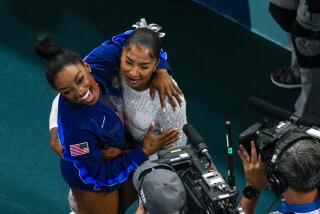Dominique Moceanu on Olympic training
- Share via
Dominique Moceanu captured the world’s attention as the youngest member of the 1996 U.S. women’s Olympic gymnastics team, the first American women’s team to ever win gold for the United States. Moceanu was just 14 when she competed that year in Atlanta and quickly became the new face of the sport.
But in her new book, “Off Balance” (Touchstone) the now 30-year-old mother of two describes as cruel the legendary coaches Bela and Martha Karolyi and criticizes the methods they used to create champions. Here, she talks about her experiences.
In your book, you talk about the training methods used by your former coaches, Bela and Martha Karolyi. Do you think that what they did is necessary at the Olympic level, or could it be toned down a bit?
I don’t think it’s necessary at the elite level. I don’t believe that it’s ethical for people to use intimidation and humiliation as a method to achieve success.
Weighing your athletes in front of their peers is humiliating. They did that at the 1996 Olympics and at training camp. [Bela Karolyi] was always using me as an example and making me feel insecure. There was name-calling — imagine being a 14-year-old girl and getting called “Easter egg,” “piggy,” “balloon.” They were using these terms when they thought I gained weight.
But they had this success in the sport, so people feel that they were doing something right.
Speaking of weight, there’s a lot of concern that the pressure to be so thin while competing at such a high level encourages eating disorders in young gymnasts. Does something need to change?
Being physically small is part of the culture of our sport. You have to wear little leotards, and judges start deducting [points] based on your physicality. But also, from an injury perspective, more pounds could lead to more wear and tear on the muscles. You may have injuries that are lingering longer. And if you’re carrying, say, 10 extra pounds, it will make your routine more difficult to get through.
So I do think our sport lends itself to being as light and as lean as possible, but there is a healthy way to do it. We need more education in our sport about nutrition and proper eating. For me, it was always just no bread, no pasta. They told you what you can’t eat, but they didn’t explain why, and when you are a small child you feel restricted. There should be a nutrition expert on staff for the elite women’s programs.
What is your exercise routine and diet like now?
I stay in shape now by going to the gym three or four days a week. I do weights, I do things like hanging on the bar, hanging sit-ups, and leg lifts — things I feel are gymnastics-based. I love working out with my husband when I can, and I run around with my kids. I do things that I feel good about and do them efficiently, and try not be in the gym for too long.
As far as diet, it took me a long time to find out what healthy was and how my body could be regulated in the correct way. As soon as I retired from gymnastics in 2000, I needed to find out how to balance my body properly since I had stopped training for 40 hours a week. At first, I stopped my diet completely and had no restrictions. I’ve come to realize that not restricting myself so much but having things in moderation is healthy. If I want a piece of chocolate, I have a piece of chocolate.
How did you recover from your experiences?
The process was a long journey. I was starting to reach healing once I met my husband. He came into my life when I was 19 and I had very little self-confidence. I was at my heaviest weight I had ever been, but he loved my curves and told me I was beautiful regardless. Finding the right person in my life healed me in so many ways. I was given love unconditionally; it wasn’t based on my gold medal or how I looked, he was just such a gentle soul with me.
But I have overcome it, and I’m so proud of that fact. A decade ago I would never have had the strength to talk openly to you about the things I’m talking about now; I wasn’t confident enough. Now I know I’m telling the truth and that I have the opportunity with my platform to help other people.
As an Olympic gymnast, you can do things physically that most people can never even dream of. What does it feel like when you’re doing a routine?
You kind of feel like a superhero sometimes. You fly in the air, you twist, you flip, you turn, you challenge yourself. You’re doing things that very few people in the world can do, and you’re at that high, high level. Your air awareness has to be very accurate, you have to be very on point with your focus, no distractions. If you hear something in the crowd, you have to ignore it.
More to Read
Go beyond the scoreboard
Get the latest on L.A.'s teams in the daily Sports Report newsletter.
You may occasionally receive promotional content from the Los Angeles Times.







